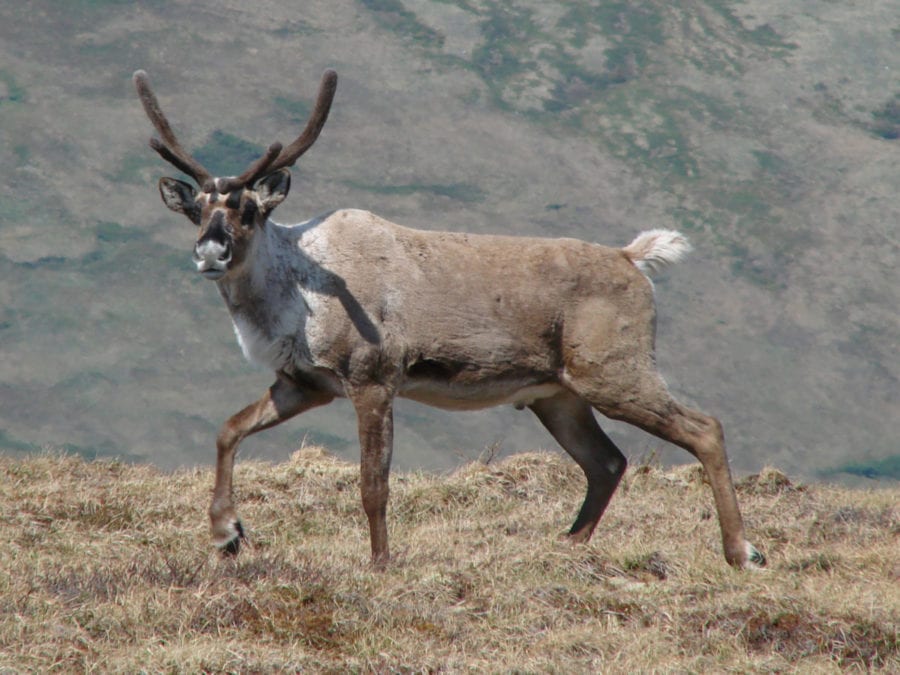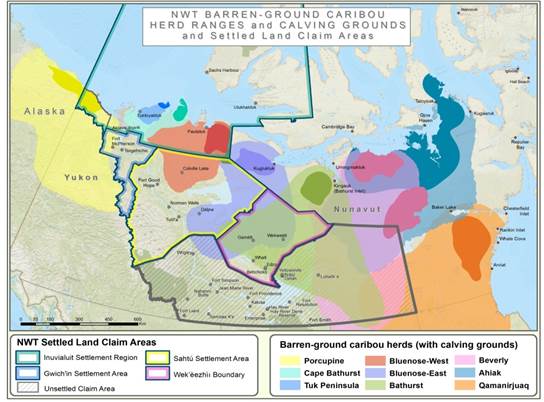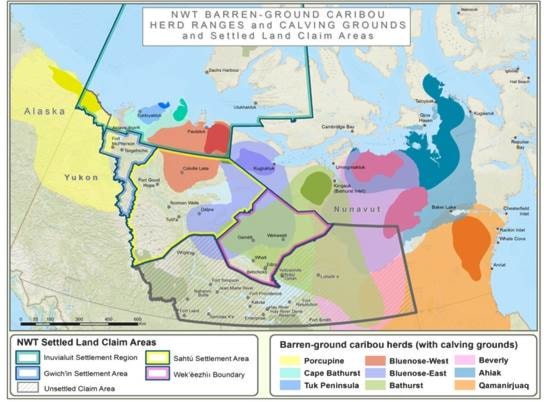David Codzi is clear when he explains that hunting is not just a recreational activity for the people of the Sahtu region, SA����Ӱ�Ӵ�ý�itSA����Ӱ�Ӵ�ý�s a way of life.SA����Ӱ�Ӵ�ý�
Codzi, president of the Ayoni Keh Land Corporation, is one of several Colville Lake leaders advocating for community-governed hunting laws.
The Sahtu Renewable Resources Board (SRRB) and a designated panel from Colville Lake are waiting to hear back from the GNWT's Department of Environment and Natural Resources (ENR) about whether the community will manage its own caribou harvesting regulations.
If the SRRB decisions are implemented, Codzi said the plan would be SA����Ӱ�Ӵ�ý�the first of its kind.SA����Ӱ�Ӵ�ý�

Wikimedia commons photo
As it stands, Colville Lake is limited by a total allowable harvest on barren-ground caribou SA����Ӱ�Ӵ�ý� the GNWT identifies the herd as Bluenose West, though some Colville Lake residents disagree with the herd definition.
A four per cent total allowable harvest was established in 2006 when a population survey showed a decline to an estimated 28,000 animals in 2006, down from approximately 110,000 adult caribou in 1992.
As an integral part of Colville Lake's way of life, Codzi said harvesting practices have always been based on respect for the animals.
SA����Ӱ�Ӵ�ý�We have our own practices that have been with us forever. I canSA����Ӱ�Ӵ�ý�t tell you when it started, but itSA����Ӱ�Ӵ�ý�s been a long time,SA����Ӱ�Ӵ�ý� he said. SA����Ӱ�Ӵ�ý�We didnSA����Ӱ�Ӵ�ý�t feel right that someone else was telling us what we should be doing and we wanted to be practising our own way.SA����Ӱ�Ӵ�ý�
In October 2019, the community put forth a conservation plan to address the declining caribou population. The issue was then discussed further in the first of five annual SRRB public consultations.
The session took place over three days in January and resulted in eight decisions and 18 recommendations put forth by the SRRB, based on SA����Ӱ�Ӵ�ý�a bio-cultural approachSA����Ӱ�Ӵ�ý� to caribou harvesting in the Sahtu region.
Among those present at the public consultation were the SRRB Board, a panel from each of the five Sahtu communities, representatives from ENR, the Inuvialuit Settlement Region, the Tlicho government, Lutsel KSA����Ӱ�Ӵ�ý�e and the Indigenous Leadership Initiative. Each had a chance to bring forward their view of how best to address the declining caribou population.
SA����Ӱ�Ӵ�ý�The idea was to try to cast a really wide net to get a wide perspective and not necessarily just as it relates to Sahtu specifically,SA����Ӱ�Ӵ�ý� said Samuel Haché, an SRRB board member and biologist for the Canadian Wildlife Service.
After recording the accounts brought forward at the hearing, SRRB spent the next several weeks weighing the evidence and putting together the SA����Ӱ�Ӵ�ý� an almost 200-page document outlining discourse from the public hearing, co-management practices and the boardSA����Ӱ�Ӵ�ý�s decisions and recommendations moving forward.
The report now sits with ENR, where minister Shane Thompson has 60 days, plus a possible 30-day extension, to accept, vary or set aside the board's decisions. However, based on the case law surrounding co-management boards, overriding their decisions would be SA����Ӱ�Ӵ�ý�challenging for (ENR) to achieve,SA����Ӱ�Ӵ�ý� said SRRB executive director Deborah Simmons.

image courtesy of ENR
In the report, SRRB determined that harvest regulations for all caribou populations must be subject to community conservation planning. Once the plan has been completed and approved, total allowable harvest limits would be removed in designated hunting regions and Colville Lake will gain ownership of its own harvesting practices.
Codzi said hunting regulations would likely be "pretty much the same" as under the GNWT's management but that the community would be asserting its rights and ownership of the land.
"Anyone who comes here to go hunting will have to ask us for permission," he said. "They have to tell us where theySA����Ӱ�Ӵ�ý�re going so we can see that everything is done respectfully."
Other SRRB decisions define a roadmap for future public consultations, including a focus on engaging youth in the communities and a commitment to continue working with co-management partners to implement community plans.
SA����Ӱ�Ӵ�ý�I think it is the way of the future in Indigenous environmental governments,SA����Ӱ�Ӵ�ý� Simmons said. SA����Ӱ�Ӵ�ý�This is about reconciliation.SA����Ӱ�Ӵ�ý�
Colville LakeSA����Ӱ�Ӵ�ý�s hunting practice has a history that surpasses Canadian law, Codzi explained, and the community has always emphasized conservation.
SA����Ӱ�Ӵ�ý�We just take what we need and thatSA����Ӱ�Ӵ�ý�s it,SA����Ӱ�Ӵ�ý� he said. SA����Ӱ�Ӵ�ý�Our livelihood is pretty dependent on one another. If we donSA����Ӱ�Ӵ�ý�t do that, we starve."

.png;w=120;h=80;mode=crop)

